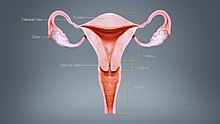User:Mr. Ibrahem/Amenorrhea
| Amenorrhea | |
|---|---|
| Other names | Amenorrhea, amenorrhœa |
 | |
| Diagram of the uterus, ovaries, and vagina | |
| Specialty | Gynecology |
| Complications | Mental health, osteoporosis, infertility[1] |
| Types | Primary, secondary[1] |
| Causes | Primary: Imperforate hymen, elevated FSH, prolactinoma, polycystic ovary syndrome[2] Secondary: Pregnancy, breastfeeding, thyroid problems, prolactinoma, anorexia, polycystic ovarian syndrome, ovarian insufficiency, hypogonadotropic hypogonadism[3] |
| Treatment | Depends on cause[1] |
| Prognosis | Not life threatening[1] |
| Frequency | 2% to 5% of women[2][3] |
Amenorrhea is the absence of menstrual periods in a woman of reproductive age.[1] It is classified as primary if periods have not started by age 14 without sexual development or by age 16 with normal development.[2] It is classified as secondary when periods stop for at least three to nine months in a women who has previously had periods.[3][4] It may result in mental health issues, osteoporosis, and infertility.[1]
Normal secondary causes are pregnancy, breastfeeding, and menopause.[3] Continuous use of hormonal birth control may also stop periods.[3] Amenorrhea may also occur due to a number of diseases.[5] Primary causes include anatomical problems such as an imperforate hymen, abnormal hormonal levels such as elevated FSH or prolactinoma, and polycystic ovary syndrome.[2] Secondary causes include thyroid problems, high prolactinoma, anorexia, polycystic ovarian syndrome, ovarian insufficiency, and hypogonadotropic hypogonadism.[3]
Diagnosis is based on the symptoms, examination, blood tests, and potentially medical imaging.[4] Pregnancy status should be determined.[1] Treatment depends on the underlying cause.[1] Amenrrhea is not life threatening.[1] Primary amenorrhea affects less than 1% of women in the United States while secondary amenorrhea, as a result of an underlying disease, affects 2% to 5%.[2][3]
References[edit]
- ^ a b c d e f g h i Nawaz, G; Rogol, AD (January 2020). "Amenorrhea". PMID 29489290.
{{cite journal}}: Cite journal requires|journal=(help) - ^ a b c d e Gasner, A; Rehman, A (January 2020). "Primary Amenorrhea". PMID 32119356.
{{cite journal}}: Cite journal requires|journal=(help) - ^ a b c d e f g Lord, M; Sahni, M (January 2020). "Secondary Amenorrhea". PMID 28613709.
{{cite journal}}: Cite journal requires|journal=(help) - ^ a b Master-Hunter T, Heiman DL (April 2006). "Amenorrhea: evaluation and treatment". American Family Physician. 73 (8): 1374–82. PMID 16669559. Archived from the original on 2008-07-23.
- ^ "Who is at risk of amenorrhea?". nichd.nih.gov/. Retrieved 2018-11-08.
